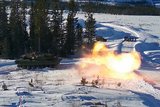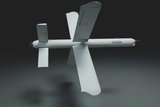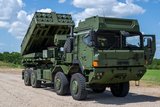US picks winner in MCWS competition
US troops inspect a 30mm Stryker Infantry Carrier Vehicle – Dragoon vehicle. (Photo: US Army/1st Lt Ellen Brabo)
Oshkosh Defense has obtained a $942 million contract from US Army Contracting Command to produce, integrate, engineer and support the fielding of Stryker Medium Caliber Weapon System (MCWS) vehicles.
The company will also provide logistics support.
‘Bids were solicited via the internet with three received,’ the DoD noted in a 3 June announcement. Shephard reported in 2020 that GDLS was bidding with Kongsberg and Leonardo DRS was teamed with Moog.
Work locations and funding will be determined with each order, with an estimated completion date of 2 June 2027.
MCWS is a new 30mm uncrewed turreted weapon (the Northrop Grumman XM813 Bushmaster chain gun) for Stryker DVHA1 vehicles.
Under the original programme schedule, vendors were to deliver MCWS bid samples by early June 2020; however, this deadline was extended to early August 2020 after the COVID-19 pandemic interrupted progress on proposals for several OEMs.
Due to these delays, the contract award date was rescheduled for April 2021 and was later delayed again until June 2021.
Shephard Defence Insight forecasts first deliveries in late FY2022 with the first unit equipped in the spring of FY2023.
Related Programmes in Defence Insight
Related Equipment in Defence Insight
More from Land Warfare
-
![Hungary set to begin using Hero 400 loitering munitions]()
Hungary set to begin using Hero 400 loitering munitions
Developed by Israel's Uvision and with systems being sold in the thousands to multiple European NATO countries and the US, the Hero family of loitering systems is also in production in the US and Italy, the latter through Rheinmetall.
-
![Light Reconnaissance Strike – enabling a vital mission set (Studio)]()
Light Reconnaissance Strike – enabling a vital mission set (Studio)
A new system-of-systems concept will unlock digital integration of sensors and weapons for Light Forces, allowing them to shape the battlefield environment on their own terms and upgrade legacy platforms.
-
![Lockheed Martin to look further afield for GMARS rocket system opportunities]()
Lockheed Martin to look further afield for GMARS rocket system opportunities
The HX truck is already in use in many NATO and allied countries around the world as a logistics vehicle and carrier for high-value systems, including missile firing weapons, so its use for the Global Mobile Artillery Rocket System makes logistical sense.






















